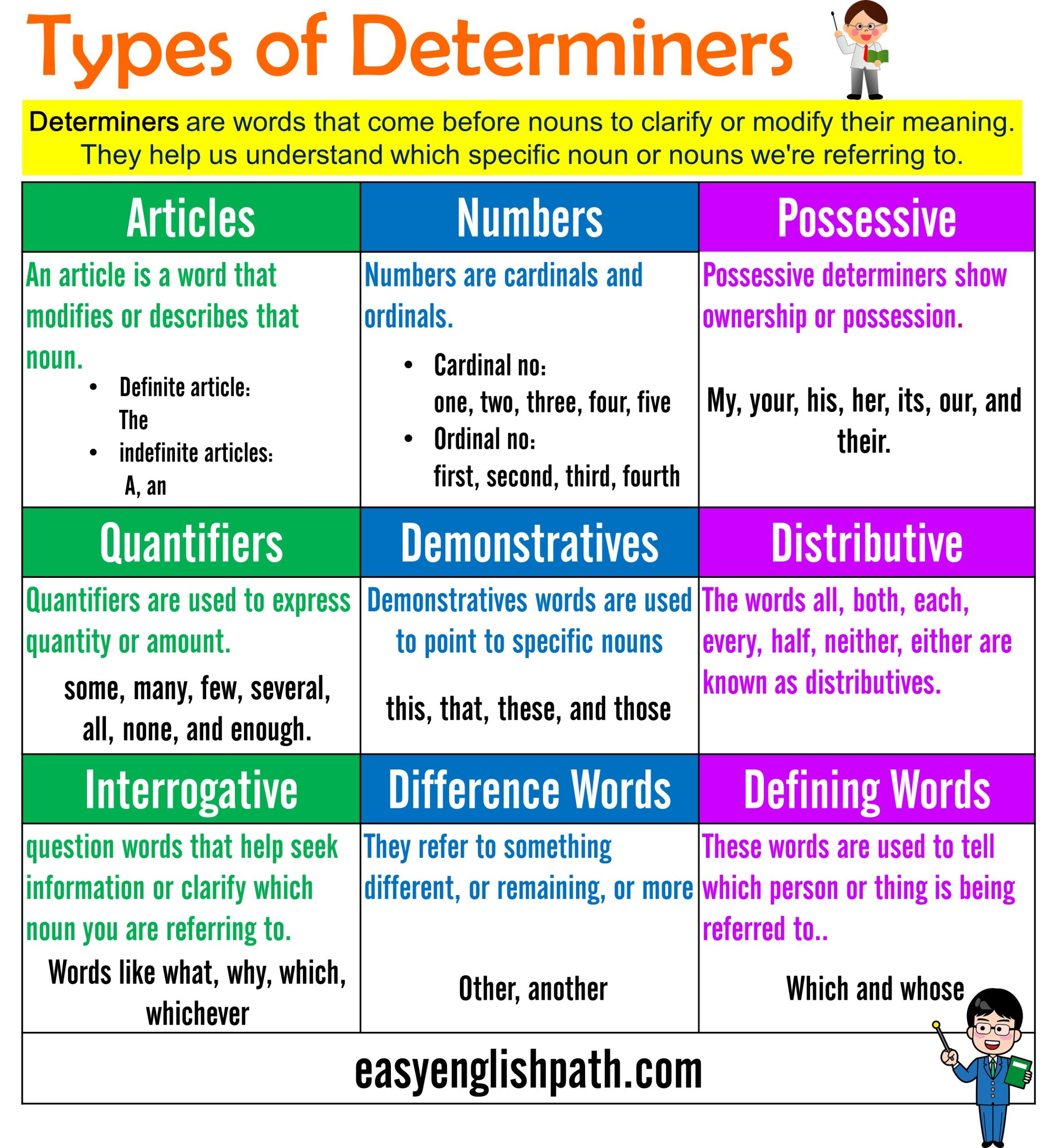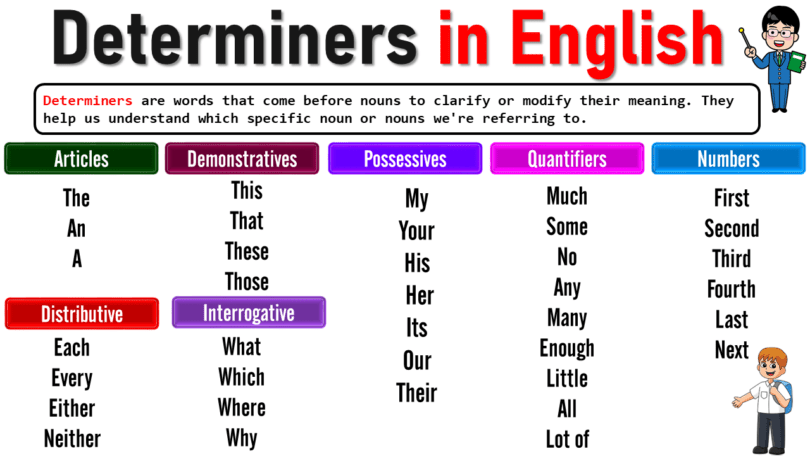Determiners help us understand and describe the nouns that are used within a sentence. They are used to tell us about something specific or something general, how many of that thing we mean, or who owns it. Determiners are extremely important because they make our sentences clearer and more meaningful.

What Are Determiners?
Determiners are words that come before nouns to clarify or modify their meaning. They help us understand which specific noun or nouns we’re referring to in a sentence. They are kind of words that are used to answer questions like ‘Which one, How many, or Whose.
Types of Determiners
1. Articles
Articles are one of the most common types of determiners. There are two articles in English: ‘The’ (definite article) and ‘A’ or ‘AN’ (indefinite articles). ‘The’ is used to refer to specific nouns, while A’ or ‘AN’ are used when we want to refer to any one of a group.
1.1: Definite Article” The”
The is used when you want to refer to a specific noun, something that both the speaker/writer and the listener/reader are familiar with or can easily identify. It is sued to indicate that the noun is unique or already known in the context.
- I saw the cat in the garden.
‘The cat‘ refers to a particular Cat, and The garden’ points to a specific garden
1. 2: indefinite Articles” A” & “An”
A and AN are used when you want to refer to a non-specific or generic noun. They specify that the noun is one of many or that the listener/reader does not yet know which one you are talking about.
- I want a book to read.
In this sentence, ‘a book‘ refers to any book: it’s not a specific book.
When to Use “A” and “An”
Use “A”
Use “A” before words that begin with a consonant sound.
- ✓ I found a book on the table.
- ✗ I found a interesting article. (‘Interesting’ begins with a vowel sound, so it should be “an”)
Use “An”
Use “An” before words that begin with a vowel sound (a, e, i, o, u).
- She has an umbrella.
- He gave me an apple.
2. Demonstratives
Demonstratives are used to point to specific nouns. Common demonstrative words are This, That, These, and Those. They help indicate closeness or distance of an object from the speaker.
This
Used for a singular noun that is nearby or within close reach.
- I like this book.
That
Used for a singular noun that is farther away or not within immediate reach.
- I remember that movie.
These
Plural form of This. Used for multiple items that are nearby.
- I love these flowers.
Those
Plural form of That. Used for multiple items that are farther away.
- I want to buy those shoes.
3. Possessives
Possessive determiners show ownership or possession. These include: My, Your, His, Her, Its, Our, Their.
My
Shows that something belongs to the speaker.
- This is my car.
Your
Indicates something belongs to the person you’re talking to.
- Is this your book?
His
Shows possession by a male.
- That is his jacket.
Her
Shows possession by a female.
- I borrowed her pen.
Its
Shows possession by an animal, object, or entity.
- The cat is washing its paw.
Our
Used to show shared ownership within a group that includes the speaker.
- We’re going on our vacation.
Their
Shows that something belongs to more than one person.
- Their house is lovely.
4. Quantifiers
Quantifiers express the quantity or amount of something. Common quantifiers: Some, Many, Few, Several, All, None, Enough
Some
Refers to an unspecified quantity that is more than zero.
- I have some free time this evening.
Many
Indicates a large quantity.
- There are many books on that shelf.
Few
Refers to a small number or limited quantity.
- There are only a few cookies left in the jar.
Several
More than a few but less than many.
- She brought several friends to the party.
All
Refers to the entire quantity.
- I ate all the pizza.
None
Indicates zero quantity.
- I have none of the ingredients for the recipe.
5. Numbers
Numbers are determiners that indicate exact quantities, like One, Two, Three, etc.
1. Count Nouns
Used with nouns that can be counted (e.g., apple, book, cat).
- There are three apples on the table.
- She has read two books this week.
- I saw five cats in the park.
2. Singular and Plural Forms
Use One for singular items and plural numbers like Three, Five for multiple items.
3. Specificity
Numbers are exact and leave no confusion. They clearly state how many items are being referred to.
4. Cardinal and Ordinal Numbers
- Cardinal numbers: One, Two, Three
- Ordinal numbers: First, Second, Third
Example:
- He is the first person in line.
- The second book on the shelf is my favorite.
Determiner vs. Adjective
| Aspect | Determiner | Adjective |
|---|---|---|
| Definition | A word used to identify, specify, or limit a noun | A word that describes or gives more information about a noun |
| Purpose | Tells which one, whose, or how many | Tells what kind, what type, or how it looks/feels |
| Position | Comes before a noun (or before an adjective + noun) | Comes before the noun, after a determiner (if present) |
| Examples | This, That, My, Some, Two, Each, Their | Beautiful, Tall, Red, Funny, Delicious |
| Example Sentence | My car is new. (“My” = determiner) | She has a red dress. (“Red” = adjective) |
| Used With | Always used with a noun | Describes a noun, can follow a determiner |
Determiners Examples
- This book is fascinating.
- Many students attended the lecture.
- I need some water.
- Both options seem appealing.
- Few people arrived on time.
- Several books were left on the shelf.
- All the cookies were eaten.
- More time is needed to complete the project.
- Little effort was put into the assignment.
- Neither choice seems ideal.
You May Also Like





